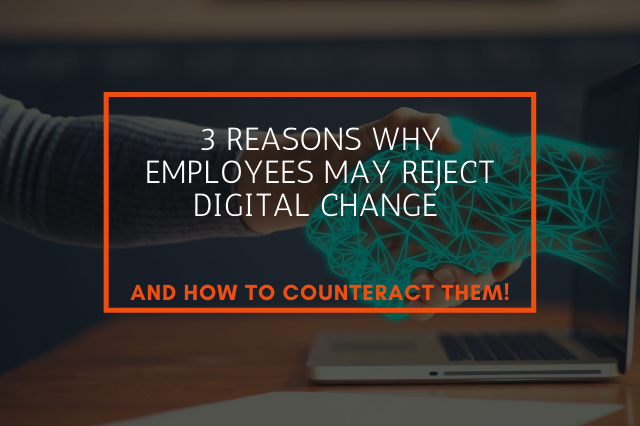
05 Jan 3 Reasons Why Employees May Reject Digital Change And How To Counteract Them
Digital change is somewhat unavoidable nowadays – but in a business where legacy processes have been long established and your employees have ingrained themselves comfortably into decade-long traditions, doing so might create a lot of disruption both internally and externally. Everything can change when you shift your business into the digital sphere, as not only may your sales, services, and how you contact your clients utterly transform, it might trigger a major rearrangement of the core roles and processes in your company.
Shifts like these will definitely create a lot of resistance to your internal stakeholders. A digital overhaul of your company will require everyone to manage deep learning curves and new processes on top of their already packed schedules, leading to less effectiveness and little to no immediate gains in the short-term. Although going digital is something logical as we look in the long-term of business and the development of the world we’re living in, the limited short-term gains make it unattractive. This is why managing this change carefully to ease your transition is extremely important.
The pace and the extent of the digital changes you implement can upset your employees – especially in the case of your middle management.
There are three major reasons why this may be the case:
1. Perceived threat
 Change is an unsettling process, and especially during the process of digitalisation, middle management can visibly see how analytical technology and data driven strategy is yanking their decision-making opportunities away, as managers may start feeling like their skills are being devalued by customer-driven data. Seeing decreasing value in their role and anxiety over less control may make many middle managers resist digital change.
Change is an unsettling process, and especially during the process of digitalisation, middle management can visibly see how analytical technology and data driven strategy is yanking their decision-making opportunities away, as managers may start feeling like their skills are being devalued by customer-driven data. Seeing decreasing value in their role and anxiety over less control may make many middle managers resist digital change.
2. Lack of Time
 Learning new processes, UI and digital structures, setting up new routines and staying in the loop for any new digital changes may take a lot of time that middle managers simply don’t have. Many managers are also shackled to legacy incentives that focus on short-term rewards, while many digital initiatives lack any incentive at all to induce managers to actively shift their priorities and start learning. Simply put, many digital initiatives are incompatible with middle managers with both time and their priorities.
Learning new processes, UI and digital structures, setting up new routines and staying in the loop for any new digital changes may take a lot of time that middle managers simply don’t have. Many managers are also shackled to legacy incentives that focus on short-term rewards, while many digital initiatives lack any incentive at all to induce managers to actively shift their priorities and start learning. Simply put, many digital initiatives are incompatible with middle managers with both time and their priorities.
3. Value

There may be new research and exciting new programs and changes that sweep the business world now and again – but whether they’re truly effective to the company is case by case basis at best. Digital change can be a blessing, but if it’s a dud, then all the effort may just be a waste of precious time that many don’t have. Therefore, many middle managers (or your employees in general) may be concerned over the potential of the digital change you’re trying to implement – and this honest questioning may easily be seen as resistance when it shouldn’t be.
Be careful not to see questioning as resistance, and when you do so, consider their concerns carefully.
Strategies to ease digital change
So how can you make your managers feel better about going digital? How can you enable them to be empowered by your digital tools and address their concerns appropriately?
Digital change managers can try these 3 strategies!
1. Frame Opportunity and Decrease Threat
To assuage concerns about the effectiveness and usage of the digital change you’re implementing, make sure you clearly communicate the leader’s motivation and vision for what the change is trying to achieve. What strategy are you trying for? What angle is this change trying to do? The more they understand, the more they apply their skillsets effectively alongside the technology, and streamline their own schedule to learn is required. This is especially true for many digital initiatives, where there’s still a lot of uncertainty. Creating a sense the opportunities available is an important step for your company to pick up the reigns and innovate within that.
2. Cohesive, educational narrative
To fully effect digital change, constant education is required from the beginning to the end. Therefore, constancy needs to be provided. Engage people wherever the people are – whether they’re break rooms, corridors, chatrooms, digital change managers can go in and help continue the narrative and keep the education going. Engagement like this can help catch people when they have time, and hammer in what you’re doing, how and why you’re doing so, and make the process transparent, and easily understood at all levels of management.
3. Digitalisation needs to be taken seriously by the company
Many digital initiatives are started but aren’t really given any effective power and status in the existing structure of the company, creating the impression that digitalisation is an ‘add-on’, which bleeds into the greater company. Giving digital management and leaders effective power to implement the changes you’ve planned and push the organisation along allows them a greater chance to achieve the results you expect, and create corresponding expectations in your employees that these systems are here to stay.
Companies can also implement rewards and retooling methods to motivate middle managers to learn new digital technologies and methods while being respectful of possible integration issues and internal disruption. Transparency and an obvious willingness to address worries (without dismissal) from the company can also ease your transition.




Sorry, the comment form is closed at this time.